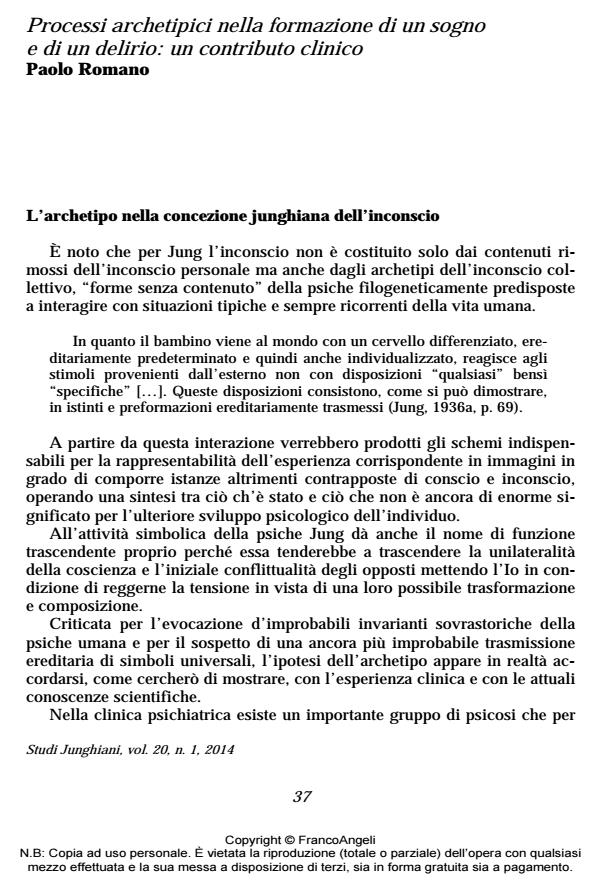Archetypal processes in the formation of a dream and a delusion: a clinical contribution
Journal title STUDI JUNGHIANI
Author/s Paolo Romano
Publishing Year 2014 Issue 2014/39 Language Italian
Pages 10 P. 37-46 File size 56 KB
DOI 10.3280/JUN2014-039003
DOI is like a bar code for intellectual property: to have more infomation
click here
Below, you can see the article first page
If you want to buy this article in PDF format, you can do it, following the instructions to buy download credits

FrancoAngeli is member of Publishers International Linking Association, Inc (PILA), a not-for-profit association which run the CrossRef service enabling links to and from online scholarly content.
After reviewing the concept of the archetype suggested by Jung in his theory of the unconscious, the Author proposes its clinical application to the interpretation of a dream and a delusional system, adding some considerations on the meaning of the symbols they contain. In particular, he shows how they could have been produced for metaphorical extension by those archetypal experiences that in the evolutionary history of man have accompanied the differentiation of our human needs from those of our animal ancestors.
Keywords: Archetype, unconscious, archetypal images, dream, delusion
- Alcaro A. (2013). Jaak Panksepp e le neuroscienze dell’affettività. Studi junghiani, 37-38: 117-120. DOI: 10.3280/JUN2013-037008
- Ammaniti M,, GalleseV. (2014). La nascita dell’intersoggettività. Milano: Cortina.
- Biondi G, Rickards O. (2014). Senza Adamo. Roma: Carocci.
- Brachen P., Thomas P., Timimi S. et al. (2012). Psychiatry beyond the current paradigm. The Britisch Journal of Psychiatry: 201, 6: 430-434 (trad. it. Una psichiatria al di là dell’attuale paradigma. Psicoterapia e Scienze Umane, 2013, 47, 1: 9-22).
- DOI: 10.1192/bjp.bp.112.109447.EagleM.N.(2011).FromClassicaltoContemporaryPshychoanalysis.Londo,NewYork:TaylorandFrancis(trad.it.DaFreudallapsicoanalisicontemporanea.Milano:Cortina,2012)
- Jung C.G. (1936a). Uber den Archetypus mit besonderer Berucksichthigung des Animabegriffes (trad. it. Sull’archetipo con particolare riguardo al concetto di Anima. In: Opere, vol. 9/1. Torino: Boringhieri, 1980).
- Jung C.G. (1936b). Der Begriff des kollektiven Unbewussten (trad. it. Il concetto di inconscio collettivo. In; Opere, vol. 9/1. Torino: Boringhieri, 1980).
- Jung C.G. (1940). Psychologie und Religion. Zurich: Rascher Verlag (trad. it. Psicologia e Religione. Milano: Ed. di Comunità,1966).
- Jung C.G. (1944). Psychologie und alchemie. Zurich: Rascher Verlag (trad. it. Psicologia e alchimia. Roma: Astrolabio, 1950).
- Jung C.G. (1958). Ein moderner Mythus, Von Dingen, Die am Himmel gesehen warden (trad.it. Su cose che si vedono nel cielo. In: Opere, vol. 10/2. Torino: Boringhieri,1986).
- Knox J (2003). Archetype, Attachment, Analysis. London: Brunner-Routdlege (trad. it. Archetipo, attaccamento analisi. Roma: Magi, 2007).
- La Bibbia (1987). Vangelo secondo Giovanni. Milano: Edizioni S. Paolo.
- Leonhard K (1957). Aufteiling der endogenen Psychosen. Berlin: Akademie Verlag (trad. it. Le psicosi endogene. Milano: Feltrinelli, 1968).
- Lettere di condannati a morte della Resistenza italiana (1952). Torino: Einaudi.
- McDowell M. (2001). Principles of organization: A dynamic system view of the archetypeas-such. Journal of Analytical Psychology, 46, 4: 637-654. DOI: 10.1111/1465-5922.00271
- Romano P. (1972). Su di un caso di euforia esaltata. Osservazioni di ordine nosografico e psicologico in margine alle manie cosiddette deliranti. Neopsichiatria, 38, 1: 85-105.
- Tellenbach H. (1960). Melancholie (Malinconia). Berlin, Gottingen, Heidelberg: Springer.
- Weitbrecht H.J. (1963). Psychiatrie Im Grundriss. Heidelberg: Springer (trad. it. Compendio di psichiatria. Padova: Piccin, 1970).
Paolo Romano, Processi archetipici nella formazione di un sogno e di un delirio: un contributo clinico in "STUDI JUNGHIANI" 39/2014, pp 37-46, DOI: 10.3280/JUN2014-039003